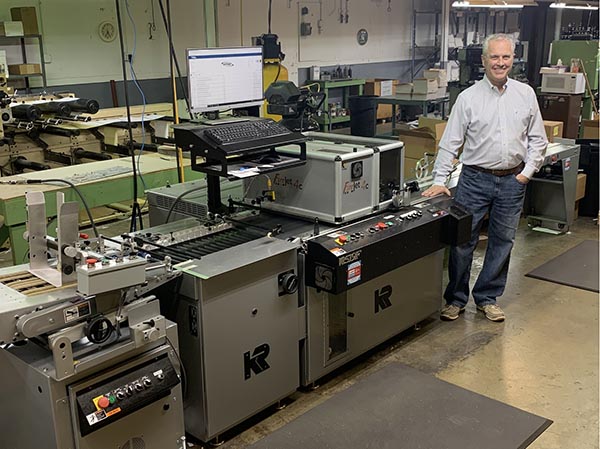Printlink, located in Battle Creek, Mich., does everything from business forms, checks, and other business support printing through a network of distributors, printers, and direct end users around the country, from their 30,000 square foot building. However, their real growth came after they acquired Palmer Envelope in 2006, and since then envelopes comprise about 50% of their volume, with color envelopes accounting for close to 20% of their total volume.
They have been using their four-color Ryobi offset presses to try to keep up with the increasing volume of orders, and even added two tabletop inkjet presses to address the shorter-run jobs, but according to the President of Printlink Paul Punnett, they realized they just needed a better solution. They looked at other high-speed envelope printers, but couldn’t justify the expensive price tag, so he went to the print show in Chicago in 2019 to see what else might solve his problem, and that is where he saw an early prototype of the Kirk-Rudy FireJet 4C. It looked like this might be exactly what they needed, and decided to become one of a select few beta sites and purchased the press.

While they were anxious to get it installed, finalizing the new printer design and COVID-19 forced them to delay the installation until February of 2021. It has now been in production for more than four months and they have worked closely with Kirk-Rudy on tweaking the new system. Punnett has been very impressed at how responsive the Kirk-Rudy engineers have been during this process. “They’re an amazing, unique company, and their quality is definitely top notch,” he said. Feeding envelopes through a printer is not necessarily an easy task, especially since there are so many sizes, configurations, and variations in thickness—even from batch to batch. The vacuum belt along with the guide wheel design makes that a much more controllable process. Unlike their tabletop presses, there really is no scuffing, and that can be an issue with heavy coverage. The FireJet has allowed them to keep the heavy coverage jobs in house rather than printing flat sheets and sending them off to have them converted which increases the cost and more importantly the delivery times.

At two to three times faster than the tabletop presses, the performance of the machine is impressive, since it can do up to 15,000 four-color envelopes an hour. It’s also less expensive to operate than the Ryobi’s since there are no plate costs or makeready. The quality of the print and the color matching, which is important to clients is exceptional, and the FireJet can even print full bleed on a coin envelope! The first and the last envelope look exactly the same, thanks to the impressive Memjet Duraflex® printheads and inks. The color control relies on the Xitron DFE, which is produced by Global Graphics, one of the leaders in print production DFE’s and inkjet printer workflows.
Printlink thinks that this new press will open up new opportunities. According to Punnett, “We will probably want to add another FireJet so we can just leave it set up for number 10 or catalog envelopes and go.” In fact, at a cost of around $80,000, he sees several of these FireJet presses in their future as the older presses start to reach end of life. Importantly, since it is a digital press, it makes it easier to bring a new labor force up to speed as older pressmen are retiring. He said he could train an operator to run the press in an afternoon.
The Powered by Memjet FireJet 4C Press from Kirk-Rudy is a unique, heavy-duty full-color inkjet printing system that is designed for production environments to handle a wide variety of applications from bags, envelopes and sheets, to napkins, coasters and more making it the most universal low-cost inkjet system on the market today. It is a prime example of an exceptional bespoke solution and what can be accomplished with production inkjet, and Printlink is happy to be a customer.
More to Come…
I would like to address your interests and concerns in future articles as it relates to the manufacturing of Print, Packaging, and Labels, and how, if at all, it drives future workflows including “Industry 4.0.” If you have any interesting examples of hybrid and bespoke manufacturing, I am very anxious to hear about them as well. Please feel free to contact me at [email protected] with any questions, suggestions, or examples of interesting applications.










Discussion
Join the discussion Sign In or Become a Member, doing so is simple and free